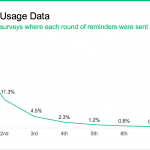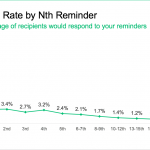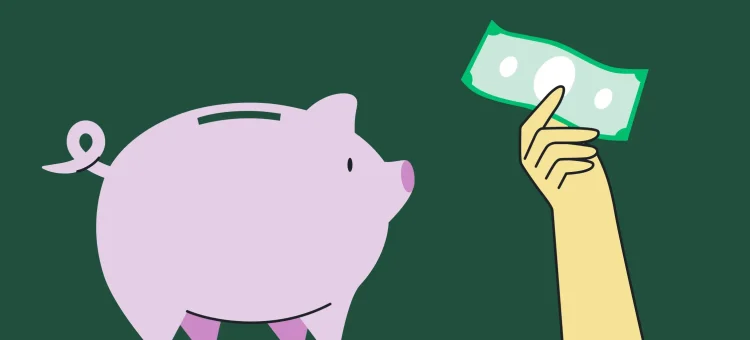Email reminders are one of the most common strategies survey creators use to boost response rates. They give you a second chance to catch recipients’ attention and bump up those response numbers on your most important surveys. There’s no doubt reminders are useful, but optimizing them effectively—without overdoing it—is a complicated art for even the most experienced survey researcher.
When should you send the first reminders? What about the second round? When should you stop? Should you send a “thank you” post-survey? Each decision adds more uncertainty. You risk irritating or alienating your audience if you’re too persistent, and losing them entirely if you wait too long. You also risk being reported as spam for each additional reminder you send—so it’s important to know when to stop.
SurveyMonkey now enables you to automate your email reminders, so you can set your timing strategy in advance, and scale it as you send out more surveys. But if you’re automating your reminders, it’s even more important that you’re thoughtful about timing.
Among the millions of surveys deployed on SurveyMonkey each year, a significant portion use emails to get more responses, with major variation in how these invites, thank yous, and reminders are implemented. We looked at the data through a broad lens to figure out the best practices associated with well-performing surveys and take some of the guesswork out of timing reminders.
Curious about reminders?
If you decide to use reminders or want send thank you's, our help center can help you set them up.
The 48 to 72 hours after your initial survey invite are the best time to send reminders
You don’t want to send reminders too early—why bother people who might already be willing participants? They only really play a role after recipients have read or disregarded previous emails. However, if you’re planning to send a reminder en-masse, it’s not time-efficient to wait until every recipient has reacted. So how should you balance this trade-off?

Find the time period that’s relevant for most of your audience. For an average survey (indicated by the green line in the chart above), as much as 86% of all responses are collected within 48 hours. After that, it’s typically time to send reminders to speed things up.
However, it also depends on your survey. The blue line above shows the 5% of surveys progress more slowly overall—these might include longer surveys, surveys sent at a busier time of year, or surveys that target a particularly busy audience. Does that sound like yours? If so, it might be worthwhile to hold for a bit longer.
Our recommended timing for sending post-survey reminders between 48 hours (for most surveys) and 72 hours (if you have reason to suspect that your respondents will be relatively slow) after the initial email.
Send reminders only when necessary, and limit yourself to a maximum of 4 rounds
Curious about how many reminders your peer survey creators typically send out? Check out the table below.

It turns out that a first round of reminders has been deployed for about 29% of all surveys and the number drops exponentially when it comes to 2nd, 3rd and 4th rounds of follow-up. There are few cases in which more than four rounds of reminders have been sent out, but according to SurveyMonkey’s system record, some creators have sent as many as 40 rounds of reminders. How do you know when to stop?
First, if your initial invites got you what you need within that 48 to 72 hour window, you clearly don’t send out any reminders. Be clear about what your response needs are at the beginning, and be ready to cut off follow-up when you’ve met those goals—especially if you’ve already set up an automated email system. It’s never worth bugging your customers, employees or whoever you’re sending surveys to if it’s not absolutely needed.
If initial invites can’t get you the number of responses you need, reminders may help, but we still recommend you limit them to 4 rounds. As a matter of fact, the efficacy of reminders generally decreases as you send out more (see the chart below), and your survey is more likely reported as spam. For the first 4 rounds, you can still expect a response rate around 3% (which can add up!), but after that, it becomes trivial.

Reminders aren’t magic. Compared to the number of responses we see from initial invites (those first impressions), the power of reminders is limited. A person is 5 times more likely to respond to your initial invite than to the 1st reminder, and the chance is even slimmer when it comes to additional rounds.
So, don’t plan to rely on numerous reminders to bump your survey responses up to the number you need. Make sure to really optimize your initial survey invites, since those are the ones that count the most—you may be surprised how much difference it makes. And when you do decide to enlist reminders, be really thoughtful about when you send them and what you’re asking for.
You don’t need to—and shouldn’t—cut email reminders out entirely. Any salesperson can tell you the importance of follow-up for getting the best results. They’re an incredibly useful tool, but they need to be used correctly.



